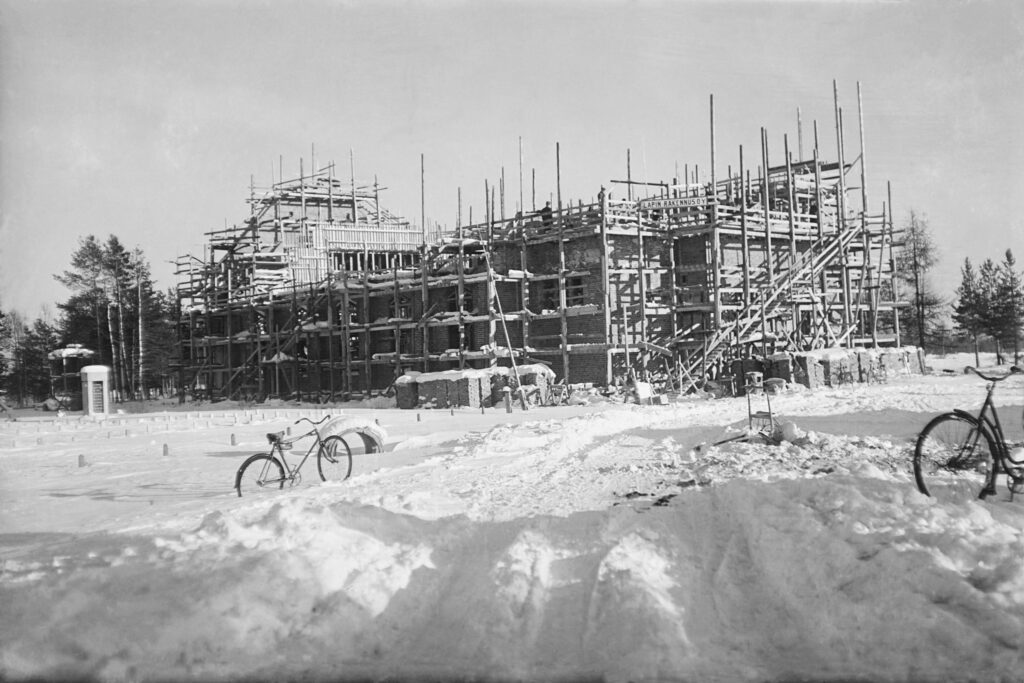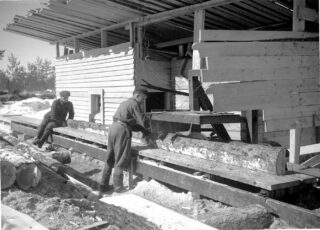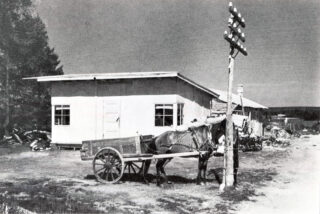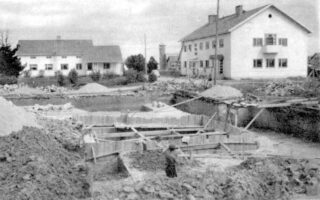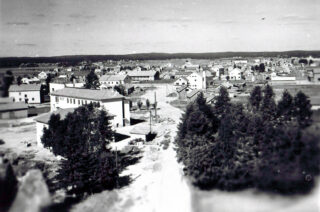During December 1944, 302 people and 20 cattle returned to Kuusamo. In the middle of January, the management board of Kuusamo municipality began to put pressure on the government that the people of Kuusamo should be allowed to return to their home region. They requested the immediate ploughing of snow of the road section between Taivalkoski and Kuusamo, the repair of bridges, the acquisition of transport equipment for the transport of people and goods, and maintenance. The road between Oulu and Kuusamo had only been ploughed to the Kostojoki bridge in January, from where the goods were transported by horses to the church town. At the beginning of 1945, the stamping, felling of reconstruction trees and driving them to construction sites began. At the end of January, the beginning of the reconstruction work was hindered by severe cold, very thick layers of snow and bad ground.
During February, the Oulu-Kuusamo highway was ploughed all the way to the Kuusamo church town. Despite February’s hard winds and cold, more than 800 people, 48 horses and about 850 cows moved to Kuusamo during the mentioned month. At the beginning of March, it was estimated that more than 8 200 people, 503 horses and 3 770 cattle had yet to be returned to Kuusamo. More than 5,000 people would have moved to Kuusamo at that time. At that time, the only liveable places in Kuusamo’s church town were in the basements of the post house and Otso co-op and a few barracks. Mail was delivered a couple times a week.
As spring arrived, the migration sped up noticeably. People tried to return while the ice was still in the lakes and the kelirikko or “rospuutto” (‘rasputitsa’) had not yet softened the roads. People were transported from Oulu to Kuusamo at a rate of 100 people per day. Sometimes the move had to be interrupted due to the Paratyphoid epidemic that broke out in Kuusamo.
By the beginning of May, 8 794 people, 390 horses, 4 439 cattle and 145 sheep had moved to Kuusamo. There were still more than 4 500 Kuusamo residents in other parishes, of which a considerable part was the population of the ceded area. By the beginning of June, more than 10 000 people had moved to Kuusamo. At this stage, reconstruction had reached a good pace, above all in the villages. Instead, people in the church town lived in dugouts built by Russians, cellars and a few barracks left behind by the Germans. Up to 10 people could live in one dugout of about 50 square meters. In addition, temporary overnighters could stay in them for several nights, because the vast majority of those who returned to the villages stayed in church town’s dugouts with friends and relatives.
The evacuation of the people from the ceded area was significantly longer than the others. Quite a lot of Paanajärvi and Tavajärvi residents lived in evacuation until 1947, when they started to be given compensation land. However, a few had taken the compensation in money and bought themselves a house in the south. Most of them returned to Kuusamo and were usually able to build themselves a new home in 1947 or 1948. During the construction period, people lived with relatives or friends.
Kuusamo rose from the ashes in the order that villages were rebuilt first and the church town last. When the villages had already been rebuilt in 1950, the church town still looked quite deserted and inconsolable. The Kuusamo church was under construction, it was finally completed in the summer of the following year. The vicar and vicarage, on the other hand, were already ready. Folk school, the thrift store, the post office, the cooperative store and Otso co-op were up and the municipal hall at the other end of Road Kitkantie was getting plastered. Most of the buildings had a fresh log surface, very little lining and paint was visible. The municipal hall and cooperative shop, the municipal department store and Otso co-op were the first to receive plastering. Reconstruction of the church town lasted until 1952. By then the hospital had its own building and the most important commercial buildings were also up. Most of the houses were one-story buildings, only the municipal hall, post office, pharmacy, hotel Koillispohja and Otso were two-story buildings. There was still a lack of paint and greenery.
Written by: Seppo Ervasti
Material: Tuhottu ja jälleenrakennettu Kuusamo
Kirjapaino Osakeyhtiö Kaleva, Oulu 1985
